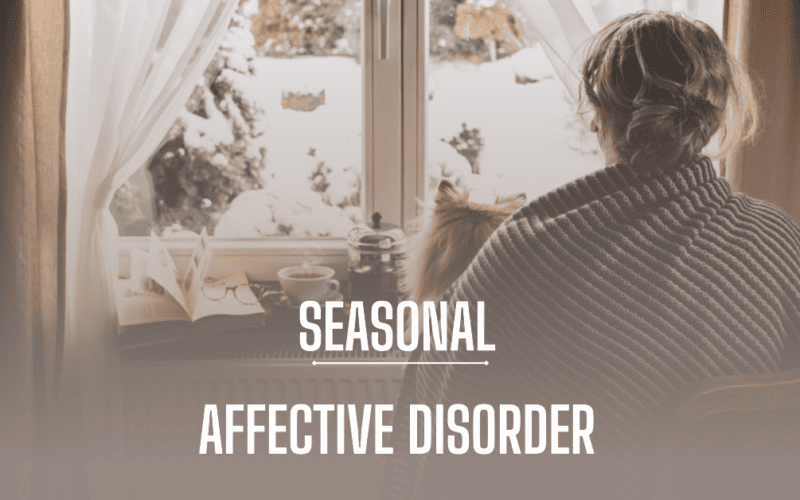The Connection Between Depression And Seasonal Affective Disorder

The winter season is often seen as a time of darkness and sadness. For some, this feeling of depression is more than just a passing emotion; it is a real psychological disorder known as Seasonal Affective Disorder (SAD). SAD causes people to experience a wide range of symptoms, including fatigue, changes in appetite or sleep habits, low energy, and difficulty concentrating.
In some cases, the symptoms can be so severe they disrupt daily activities and cause a person to feel completely overwhelmed by the darkness of winter.
Seasonal Affective Disorder is a type of depression that primarily affects individuals during the winter months. It is believed to be caused by a combination of genetic and environmental factors that result in a disruption of the body’s natural circadian rhythms.
While the exact causes of SAD are still unknown, research suggests that a decrease in serotonin and other hormones may play a role in the development of the disorder. Additionally, individuals may be at higher risk of developing SAD if they have a family history of depression, are female, or live in areas with shorter winter days.
Symptoms of Seasonal Affective Disorder
Manifestations of Seasonal Affective Disorder can vary in severity and type. Generally, the symptoms of Seasonal Affective Disorder (SAD) include low mood, fatigue, difficulty concentrating, difficulty sleeping, irritability, and a lack of interest in activities that were once pleasurable.
These symptoms begin in the fall and winter months, and can last into the spring. In some cases, the symptoms may remain for the entire year. Other less common symptoms can include changes in appetite, weight gain, and feelings of hopelessness.
In order to be diagnosed with SAD, these symptoms must be present for at least two consecutive years and interfere with daily life. In addition, these symptoms must not be caused by any other medical condition or medication. A diagnosis of SAD should be done by a qualified medical professional, such as a psychiatrist.
Treatment for SAD typically includes light therapy, psychotherapy, and medication.
Causes of SAD
The prevalence of SAD has been linked to a variety of causes, with the primary culprit being a lack of sunlight, often referred to as the ‘winter blues’. The lack of sunlight can cause a disruption in the body’s natural circadian rhythm, which is responsible for regulating the sleep-wake cycle.
Other environmental factors include:
- Temperature:
- Colder temperatures can lead to a decreased production of serotonin, which is responsible for maintaining a positive mood.
- Longer nights can lead to a decrease in natural melatonin production, which can lead to feelings of depression.
- Daylight Savings Time:
- The disruption of the body’s natural circadian rhythm due to the changing of the clocks can cause feelings of depression and fatigue.
- The increased darkness in the morning can cause feelings of sadness and lethargy.
Other potential causes of SAD include genetic factors, social factors, and psychological factors. Genetic factors such as family history of depression can increase the risk of developing SAD.
Social factors such as isolation and lack of social support can also contribute to the development of SAD.
Psychological factors such as low self-esteem and negative thinking can also lead to feelings of depression.
Risk Factors for SAD
Certain individuals may be at a higher risk of developing Seasonal Affective Disorder, such as those with a family history of depression, those who are socially isolated and lack support, or those with low self-esteem and negative thinking.
Additionally, other risk factors may include a lack of access to natural sunlight, an overall poor diet, an insufficient amount of exercise, or the use of certain medications that can cause depression.
Furthermore, certain individuals may also be more likely to experience SAD due to their lifestyle, such as students who are overworked with little to no breaks, those who travel frequently and may experience jet lag, or those with irregular sleeping patterns.
It is important to note that SAD can affect anyone regardless of age, gender, or background, and can be present in both adults and children.
Therefore, it is important to be aware of the risk factors for SAD and to take the necessary steps to ensure that it is treated properly.
Diagnosing Seasonal Affective Disorder
Diagnosis of Seasonal Affective Disorder can be challenging, as the symptoms may overlap with those of other mental health issues, such as Major Depressive Disorder or Bipolar Disorder. It is estimated that up to 10% of the population in the United States experiences SAD each year.
To diagnose SAD, mental health professionals typically use a combination of:
- Comprehensive medical and mental health history
- Physical examination
- Psychological tests
- Lab tests
The doctor will also ask questions about symptoms, such as the timing and duration of symptoms, and the level of functioning. Once the diagnosis is made, the doctor will work with the patient to determine the best treatment plan for their specific needs. Treatment may include medications, psychotherapy, light therapy, and lifestyle changes.
Treatments for SAD
Treatment of Seasonal Affective Disorder may involve a variety of approaches, ranging from medications to lifestyle modifications.
Medications typically used to treat SAD include antidepressants, such as selective serotonin reuptake inhibitors or serotonin-norepinephrine reuptake inhibitors. These medications work by increasing the amount of serotonin in the brain, which can help reduce depressive symptoms.
Light therapy, also known as phototherapy, is a popular treatment which involves exposure to artificial light to simulate natural daylight. This can be done using a light box, which emits a specific wavelength of light, or with dawn simulation, which uses a timer to gradually brighten a room to simulate the natural sunrise. In the case of SAD, light therapy can help reduce symptoms such as fatigue, low mood, and difficulty concentrating.
Additionally, lifestyle modifications, such as physical activity, stress reduction, and social activities, can be beneficial in treating SAD. Exercise has been linked to improved mood and sleep quality, and engaging in social activities such as attending events and spending time with family or friends can help lift mood and reduce feelings of isolation.
Conclusion
The impact of seasonal affective disorder on mental health is well-documented. Studies show an alarming correlation between the onset of SAD and depression, making it a critical issue to address.
The symptoms of SAD are often difficult to distinguish from other mental health disorders, making diagnosis challenging for both patients and physicians. Fortunately, many treatments are available to help manage the symptoms of SAD, giving sufferers the support they need to live a healthy and productive life.
Although SAD is a serious condition, it is possible to succeed in managing the condition with the proper care and treatment. With the right approach, SAD can be managed and the effects of depression can be minimized.
By taking a proactive stance, individuals can find the help they need to live a life of balance and contentment.








